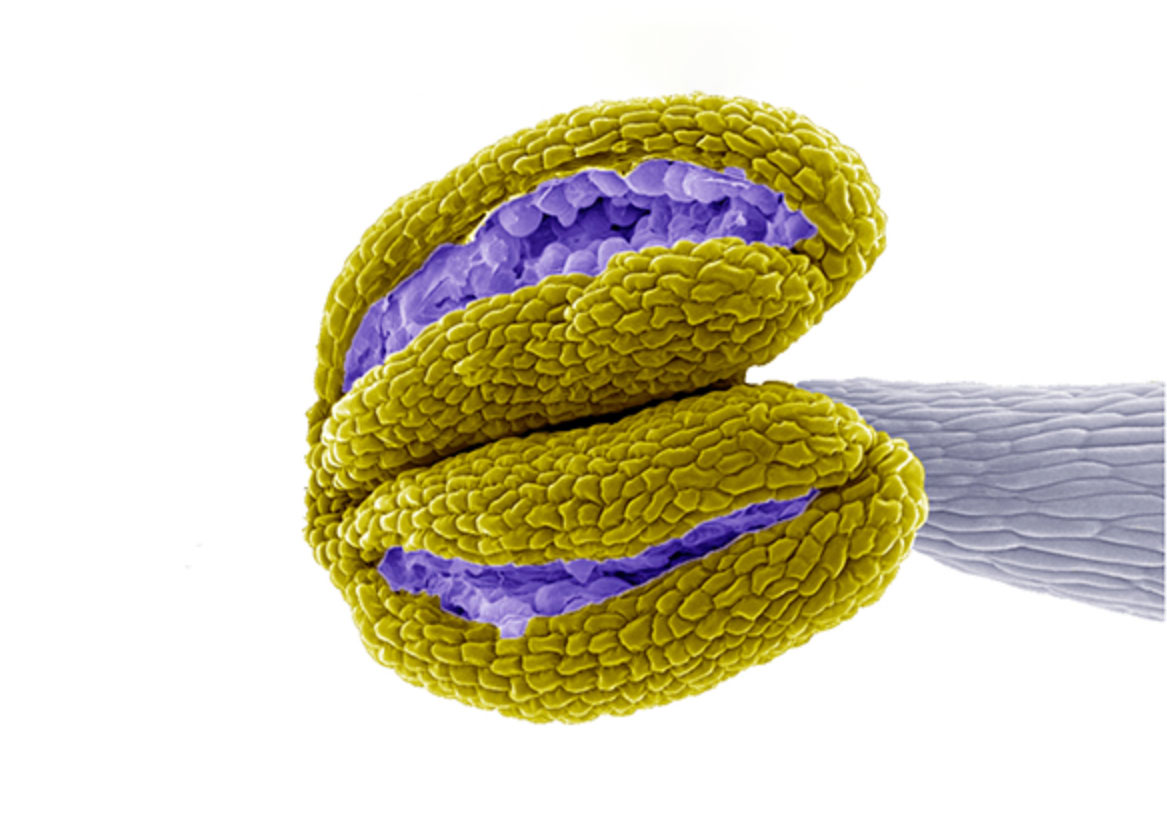
Nicole Giese Rura | Whitehead Institute
April 2, 2019
Cambridge, MA — Increased temperatures and decreased precipitation associated with climate change could threaten the world’s crops. Seed and pollen production in particular are vulnerable to shifts in temperature or rainfall. For example, in heat- or drought-stressed wheat and rice, the tissue responsible for nourishing pollen, called the tapetum, is compromised, causing the plants to not generate pollen. Without pollen, these staples are unable to bear the grains that billions of people rely on for food. In research described this week in the journal Plant Cell, Whitehead Institute Member Jing-Ke Weng and his lab have identified the components of a critical scaffold system that supports the tapetum. With a better understanding of the tapetum, scientists may be able to adapt plants to produce pollen even in hot, arid conditions.
Within a flower bud, pollen-filled anthers perch atop stalk-like filaments. Lining the anther’s inner chamber is a tissue called the tapetum, which nurtures the developing pollen. To better understand pollen and anther formation, Joseph Jacobowitz, a graduate student in Weng’s lab and first author of the Plant Cell paper, analyzed genes active in the anther during early flower development in the Arabidopsis plant. Two practically unknown genes stood out because they likely contribute to pollen maturation: PRX9 and PRX40. After further investigation, Jacobowitz determined that the two genes encode enzymes that work in conjunction with another type of protein called extensin and together they form the supportive walls that act like a scaffold in the tapetum.
Weng, who is also an assistant professor of biology at Massachusetts Institute of Technology, likens extensins to bricks in a wall and the PRX9 and PRX40 proteins to the mortar. Pushing against a wall can easily compromise its structure unless mortar bonds the bricks together. The same seems to be true with extensins and PRX9 and PRX40. The extensins and PRX9/PRX40 wall in the tapetum remained intact until Jacobowitz genetically “knocked out” the mortar genes. With the mortar gone, the scaffolding loses its integrity, and the tapetum collapses into the space where the pollen develops, either crushing or starving it. The result appears similar to what occurs in the tapetum of stressed wheat and rice plants, and the final effects are similar as well: Both the stressed crops and Arabidopsis lacking PRX9 and PRX40 are male sterile and do not produce pollen.
After further investigation, Jacobowitz and colleagues determined that the PRX9 and PRX40 genes are closely related and first appeared at pivotal moments in plant history. PRX40 is highly conserved among land plants and originated about 470 million years ago, when plants first emerged onto land from the seas and rivers. PRX9 seems to have evolved from PRX40 as a redundant backup when flowering plants diverged from nonflowering plants.
Pollen creation is a delicate process that plants have evolved over millions of years. Insights such as these into how plants maintain the integrity of their reproductive system are invaluable toward understanding how we might be able to generate crops capable of withstanding environmental stresses like heat and drought that could threaten our food supply.
This work was supported by Pew Scholars Program in the Biomedical Sciences (27345), the Searle Scholars Program (15-SSP-162), and the National Science Foundation (CHE-1709616 and 1122374).
Written by Nicole Giese Rura
***
Jing-Ke Weng’s primary affiliation is with Whitehead Institute for Biomedical Research, where his laboratory is located and all his research is conducted. He is also an assistant professor of biology at Massachusetts Institute of Technology.
***
Citation:
“PRX9 and PRX40 are extensin peroxidases essential for maintaining tapetum and microspore cell wall integrity during Arabidopsis anther development”
Plant Cell, online March 18, 2019, DOI: https://doi.org/10.1105/tpc.18.00907
Joseph R. Jacobowitz, William C. Doyle, and Jing-Ke Weng.
